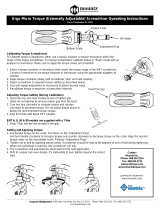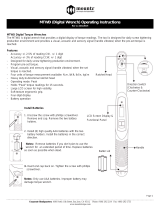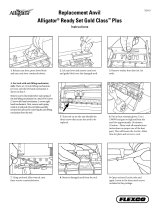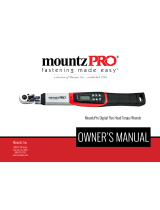Page is loading ...

1
PULSETOOLS
INSTRUCTIONMANUAL
&
MAINTENANCE
PISTOL TYPE
Rev 3.0 (7/12/2011)
READ ALL THE INSTRUCTIONS COMPLETELY BEFORE OPERATION.
COMPLY WITH ALL THE INSTRUCTIONS AND RULES IN THIS MANUAL AND SAVE THIS MANUAL
FOR FUTURE REFERENCE.

Mountz Inc. 1080N 11
th
Street, San Jose CA 95112 Ph (408) 292-2214 Fax (408) 292-2733 www.mountztorque.com
2
CHART OF CONTENTS
General Safety Rules and Replacement and Maintenance ………………………………………………….. Page 2
Steps for Torque Adjustment – Pistol Type ...………………………………………………………………….. Page 3
Recommendations for service…………………………………………………………………………………… Page 4, 5
Disassembly / Assembly for Pulse Wrenches and Drivers – Pistol Type, Non-Shut off …………….……. Page 6
Pulse Mechanism Disassembly ……………………………………………………………………….. Page 6
Pulse Unit Assembly ……………………………………………………………………………………. Page 9
Housing and Motor Set Disassembly …………………………………………………………………. Page 20
Housing and Motor Set Assembly …………………………………………………………………….. Page 22
Disassembly/ Assembly for Pulse Wrenches and Drivers – Pistol Type, Shut off …………………………. Page 26
Pulse Mechanism Disassembly ……………………………………………………………………….. Page 26
Pulse Unit Assembly ……………………………………………………………………………………. Page 29
Housing and Motor Set Disassembly …………………………………………………………………. Page 40
Housing and Motor Set Assembly …………………………………………………………………….. Page 44
Trouble Shotting………………………………………………………………………..…………………………. Page 46

Mountz Inc. 1080N 11
th
Street, San Jose CA 95112 Ph (408) 292-2214 Fax (408) 292-2733 www.mountztorque.com
3
General Safety Rules
ALWAYS OBSERVE THE FOLLOWING RULES TO ASSURE SAFE USE OF THE TOOLS!!
Do not operate the pulse tools unless you fully understand the instructions contained in
this manual. If any unclear, please contact the agents.
Never expose to rain or use in damp locations.
Always use the proper pressure at air inlet. Apply either less or exceed air inlet pressure
will affect the performance of the tools, including quality, torque, function, and life, then
lead to damage.
Air inlet pressure standard
70PSI – 85PSI (5.2kg/cm
2
~6.2kg/cm
2
)
Always add oil about 0.5~1cc at air inlets at least every week to maintain the
performance and the life of the pulse tools.
Keep children away. Tools must need to be kept in a safe and clean position where
children cannot reach.
DO NOT force tools. The tool will be damaged easily and quickly if over-load over 15
seconds.
Always use the proper length of air hose. The length of air hose shall not exceed
5 meters
, or the pressure reduces. Do be sure the air inlet pressure is in between the
standard number(70PSI – 85PSI) before operating tools.
Always use safety glasses and earphone.
Always operate the tools by two hands. One hand operation may cause risk of injury to
persons.
Disconnect the air hose and the quick nipple after operating tools. Be sure to return
tools to safety position. Tools drop or unintentionally contact can cause risk of injury.
Install the safety buckle to avoid tools drop while operating in high position.
Never contact with any electricity conducted objects to avoid electricity shock hazard.
Replacement and Maintenance
(1) Never try to repair or replace the defective tools by others under the warranty period. The
authorized service centers have the right to refuse or certain fee may incur for extra repair
work.
(2) Keep all related servicing records for future repairs, maintenance, and adjustment.
(3) The warranty does not apply to accessories or damage caused where repairs have been
made or attempted by others
(4) Mountz will repair, without charge, any defects due to faulty material under the warranty
period
(5) The warranty does not cover part failures due to normal wear and tool abuse, and damage
caused due to any appropriate appliances, i.e. tool over loaded, improper air inlet
pressure and air hose size, unauthorized replacement parts.

Mountz Inc. 1080N 11
th
Street, San Jose CA 95112 Ph (408) 292-2214 Fax (408) 292-2733 www.mountztorque.com
4
Fig.3
Steps for Torque Adjustment – Pistol Type
1. Loosen the screw on the pulse unit housing.
2. Rotate the anvil manually; make the valve screw inside the pulse unit aim at the hole (where the screw taken
off). Then, use the attached tool to adjust the torque. Torque increased by turning clockwise and vise versa。
3. Tighten the screw back to the pulse unit housing.
Increase tor
q
ue
Reduce torque
Fig.2
Fig.4
Fig.1

Mountz Inc. 1080N 11
th
Street, San Jose CA 95112 Ph (408) 292-2214 Fax (408) 292-2733 www.mountztorque.com
5
RECOMMENDATIONS FOR SERVICE
The pulse tool requires regular maintenance to ensure the tool operates at optimal performance. The type of routine
maintenance and the frequency is dependent on the application and how the tool is used. The pulse tool requires preventive
maintenance like oil changes and have the parts inspected periodically. Regular oil changes will increase the life cycle of the
tool, reduce maintenance costs and allow the tool operate properly.
When is first service required? There are several factors that influence the maintenance schedule: 1: Type of application, 2)
The torque setting within the torque range of the pulse tool, and 3) The number of cycles the tool is used daily, weekly and
monthly.
1) The first service is recommended at 250,000 pulse-seconds. The oil needs to be changed. Inspect all the soft parts of the
pulse unit (the soft parts are referenced as the "Repair Kit" - see parts list document for that model). The Repair Kit includes
all the necessary parts and it is recommend to be performed every six months at minimum, based upon use of the tool.
2) The second service is recommended at 500,000 pulse-seconds. The oil needs to be changed. All soft parts of the pulse
unit need to be replaced (the soft parts are referenced as the "Repair Kit" - see parts list document for that model). Inspect
the hard parts of the pulse tool (the hard parts are referenced as the "Service Kit" - see parts list document for that model).
This maintenance service may occur once or twice a year at minimum, based upon use of the tool.
It is recommended that after 250,000 pulse-seconds the pulse tool should be evaluated for general performance and oil
condition as part of its standard preventive maintenance. If the tool fails before the 250,000 pulses-seconds then the pulse
unit needs to be rebuilt, with the "Repair Kit" and "Service Kit" (see parts list document for that model). Note! Always it is
important to make sure the tool has clean, dry and lubricated air at the recommended pressure supplied to it.
A pulse-second is not every second the tool is running, only when it’s "pulsing" and applying torque. Typically, the tool does
not start pulsing until after the fastener is snug, unless there’s considerable prevailing torque. When operating the tool on
the fastener, start counting once the tool begins pulsing. You can use a watch with a second hand and time it until the tool
automatically shuts-off. Use the information to calculate how many pulse-seconds the tool performs per application each
day. Then perform some basic math to calculate the tool’s maintenance schedule. Use this formula.
# Pulsing Seconds ÷ Total of Pulsing Time = No Cycles
Note! Please include the rework, reverse, or retightening time involved on the operation to calculate the accurate
pulsing time. Here is an example:
Pulsing Time = 2 seconds
Pulses- seconds recommended = 250,000
250,000 pulses-sec ÷ 2 sec = 125,000 cycles
Taking the example above, to estimate the maintenance period can be follow by the following
No of Fasteners Pulsing Time per
Fastener
No of parts
assembled per day
Calculation No of days to inspect the
tool
7 2 seconds 300 125,000 /(300*7) = 59 59 days

Mountz Inc. 1080N 11
th
Street, San Jose CA 95112 Ph (408) 292-2214 Fax (408) 292-2733 www.mountztorque.com
6
Regularly the hard joint pulse in average 0.5 sec, and the soft joint is average is 2 seconds, based on the above example, if
the tool has not drop-off the performance, the service to change the oil fluid is after approximately 59 work days. However
the application can be expose of extreme conditions (poor air supply, extended pulsing times, torque setting at the high end
of tool range, high number of cycles), the maintenances intervals may need to be reduced.
TOOL MODEL Repair Kit Item No Service Kit Item No
AUTO SHUT-OFF MODELS
FLEXS-40P 63- IS40RK -E05A 63- IS40SK -E05A
FLEXS-50P 63- IS50RK -E05A 63- IS50SK -E05A
FLEXS-60P 63- IS60RK -E05A 63- IS60SK -E05A
FLEXS-70P 63- IS70RK -E05A 63- IS70SK -E05A
FLEXS-90P 63- IS90RK -E05A 63- IS90SK -E05A
FLEXS-100P 63- IS100RK -E05A 63- IS100SK -E05A
FLEXS-130P 63- IS130RK -E05A 63- IS130SK -E05A
FLEXS-150P 63- IS150RK -E05A 63- IS150SK -E05A
FLEXS-30PX 63- IS30DRK -E05A 63- IS30DSK -E05A
FLEXS-40PX 63- IS40DRK -E05A 63- IS40DSK -E05A
FLEXS-50PX 63- IS50DRK -E05A 63- IS50DSK -E05A
FLEXS-60PX 63- IS60DRK -E05A 63- IS60DSK -E05A
NON SHUT-OFF MODELS
FLEX-40P 63- I40RK -E05A 63- I40SK -E05A
FLEX-50P 63-I50RK -E05A 63-I50SK -E05A
FLEX-60P 63-I60RK -E05A 63-I60SK -E05A
FLEX-70P 63-I70RK -E05A 63-I70SK -E05A
FLEX-90P 63-I90RK -E05A 63-I90SK -E05A
FLEX-100P 63-I100RK -E05A 63-I100SK -E05A
FLEX-130P 63-I130RK -E05A 63-I130SK -E05A
FLEX-150P 63-I150RK -E05A 63-I150SK -E05A
FLEX-30PX 63- I30DRK -E05A 63- I30DSK -E05A
FLEX-40PX 63- I40DRK -E05A 63- I40DSK -E05A
FLEX-50PX 63-I50DRK -E05A 63-I50DSK -E05A
FLEX-60PX 63-I60DRK -E05A 63-I60DSK -E05A

Mountz Inc. 1080N 11
th
Street, San Jose CA 95112 Ph (408) 292-2214 Fax (408) 292-2733 www.mountztorque.com
7
DISASSEMBL
Y
/
ASSEMBLY FOR PULSE WRENCHES
FLEX-40P, FLEX-50P, FLEX-60P, FLEX-70P, FLEX-90P, FLEX-100P, FLEX-130P, FLEX-150P FLEX-30PX, FLEX-40P
X
,
FLEX-50PX, FLEX-60PX
PULSE MECHANISM DISASSEMBLY
1.0 Quick Change Holder Assembly
: (for Model No. FLEX-30PX, FLEX-40PX, FLEX-50PX, FLEX-60PX)
Press down the hold spacer, and find the anvil collar. Use the a needle like stuff to get the anvil collar out,
then take the quick change holder, the hold spacer, the spring, and the steel ball apart.
The steel ball may drop off when taking out the Quick Change Holder
2.0 Pulse Unit Housing Disassembly
:
Fix the tool by a vise, use an adjustable Chart wrench clockwise to loosen the pulse unit housing until the
pulse unit housing detach from the motor housing. Then, take the pulse unit out (Fig 6).
Vise
Note: Handle rubber must be
covered by a piece of cloth to
avoid damage
Fig.6
Vise
Fig.5
Note: Handle rubber must be
covered by a piece of cloth to
avoid damage

Mountz Inc. 1080N 11
th
Street, San Jose CA 95112 Ph (408) 292-2214 Fax (408) 292-2733 www.mountztorque.com
8
3.0 Pulse Unit Disassembly
:
3.1 Fix the pulse unit by a vise. Use the appliance (see Chart 1) to loosen the lock nut on the pulse unit,
Fig. 7.
Note: LoctIte was applied on the lock nut when tools assembled.
3.2 Put the Appliance, see Chart 2, on the anvil and tap on it slightly to detach the interior parts from
the pulse unit, Fig. 8.
Appliance No. Apply to
63-TDI-40RT001
FLEX-40P, FLEX-50P, FLEX-60P, FLEX-30PX ,
FLEX-40PX , FLEX-50PX , FLEX-60PX
63-TDI-70RT001 FLEX-70P
63-TDI-90RT001 FLEX-90P
63-TDI-100RT001 FLEX-100P
63-TDI-130RT001 FLEX-130P
63-TDI-150RT001 FLEX-150P
Appliance No. Apply to
63-TDI-40RT002
FLEX-40P, FLEX-50P, FLEX-60P,
FLEX-70P,FLEX-30PX ,FLEX-40PX ,
FLEX-50PX , FLEX-60PX
63-TDI-90RT002
FLEX-90P, FLEX-100P, FLEX-130P,
FLEX-150P
App
liance
Fig. 8
Chart 1
Chart 2
Fig.7
Appliance

Mountz Inc. 1080N 11
th
Street, San Jose CA 95112 Ph (408) 292-2214 Fax (408) 292-2733 www.mountztorque.com
9
4.0 Parts of Pulse Cylinder Unit:
a) FLEX-40P, FLEX-50P, FLEX-60P
b) FLEX-70P, FLEX-90P
c) FLEX-100P

Mountz Inc. 1080N 11
th
Street, San Jose CA 95112 Ph (408) 292-2214 Fax (408) 292-2733 www.mountztorque.com
10
d) FLEX-130P
e) FLEX-30PX ,FLEX-40PX , FLEX-50PX , FLEX-60PX
PULSE UNIT ASSEMBLY
:
1.0 Pulse Cylinder Unit Assembly
:
1.1 Install the pins on both sides of the pulse cylinder. (Fig. 9)
1.2 Sleeve the O-ring to the valve and install the valve into the big hole on the pulse cylinder. (Step 1;
Fig.10)
1.3 Insert the pin into the hole on the side of the pulse cylinder. (Step 2; Fig.11)
1.4 Screw the valve screw to the pressure valve. (Step 3; Fig.11)
Pin
Pin
Pulse Cylinder
Fig.9

Mountz Inc. 1080N 11
th
Street, San Jose CA 95112 Ph (408) 292-2214 Fax (408) 292-2733 www.mountztorque.com
11
Small hole
Big hole
O-ring
Step 1; Fig.10
Valve screw
Step 2; Fig.11
Pin
Step 4; Fig.12
Block Cap
Step 6; Fig.14
Front Plate
NOTE: the valve screw MUST screw to the most bottom position certainly.
1.5 Plug the block cap into the hole and make sure it is parallel to the surface of the pulse cylinder.
(Step 4; Fig. 12)
1.6
Put the spring into the hole then install the pressure valve that with the O-ring sleeved.
(Step 5; Fig. 13)
1.7 Install the front plate and make sure the corresponding position with the pins. (Step 6; Fig. 14)
1.8 Sleeve the O-ring on the valve screw and press into the hole. Make sure it is parallel to the surface
of the front plate. (Step 7; Fig. 15)
Pressure Valve
Spring
Step 5; Fig.13
Corresponding position
O-ring
Step 7; Fig.15

Mountz Inc. 1080N 11
th
Street, San Jose CA 95112 Ph (408) 292-2214 Fax (408) 292-2733 www.mountztorque.com
12
Fig.18
Front Plate
2.0 Anvil Unit Assembly
Install the roller to the drive blade, then insert the springs into the anvil and press the blades from both
sides. Finally put the anvil to the pulse cylinder to complete the anvil unit assembly.
NOTE: RECOMMENDED UTILIZE THE SPECIAL FIXTURE FOR EASIER INSTALLATION FOR THE ANVIL
WITH THE ROLLER AND THE BLADE INTO THE CYLINDER
FIXTURE PART No TOOL MODEL
63-I40AST-001K FLEX-40P, FLEX-50P, FLEX-60P,
FLEX-40PX, FLEX-50PX, FLEX-60PX,
63-I70AST-001K FLEX-70P
63-I90AST-001K FLEX-90P
63-I100AST-001K FLEX-100P
63-I130AST-001K FLEX-130P
63-I150AST-001K FLEX-150P
MUST follow the direction as Fig.18 showed while installing the anvil unit into the pulse cylinder; be sure to
aim at the highest points by two sides of the interior pulse unit and press the two drive blades in slowly.
3.0 Front Cover and Rear Plate of Pulse Cylinder Assembly ( For the models FLEX-40P, FLEX-50P, FLEX-60P,
FLEX-30PX ,FLEX-40PX , FLEX-50PX , FLEX-60PX)
3.1 (a) Install the rear plate to the pulse cylinder and be sure the positions of the pin and the hole are
corresponded. (Fig. 19) Then, plug the pressure valve with the convex facing outside in the hole on the
rear plate.
(b) Put the X-ring on the anvil with the oil applied. (Fig. 20)
(c) Install the front cover to the pulse cylinder by the corresponding positions. (Fig. 21)
Fig.17
Press
Press
Fig.16
Roller
Drive Blade

Mountz Inc. 1080N 11
th
Street, San Jose CA 95112 Ph (408) 292-2214 Fax (408) 292-2733 www.mountztorque.com
13
Pressure Valve
Rear Plate
O-ring
3.2 After installing the front cover, put the O-ring on the greasing screw, then tighten the greasing screw
but not tighten it completely.
FLEX-70P, FLEX-90P
3.1 (a) Install the rear plate that with the O-ring sleeved (Fig. 23). Make sure the positions of the pin and
hole are exactly matched. Then, plug the pressure valve with the convex facing outside in the hole
on the rear plate.
(b) Put the back up ring and the X-ring into the front cover. (Fig. 24)
(c) Install the front cover to the pulse cylinder by the corresponding positions. (Fig. 25)
3.2 After installing the front cover, put the O-ring on the greasing screw, then tighten the greasing screw
but not tighten it completely.
Greasing screw
O-ring
Fig.22
Fig.26
O-ring
Greasing screw
(b) Fig.20
X-ring
(c) Fig.21
Front Cover
Corresponding position
Back Up Ring
Front Cover
X-ring
Corresponding position
(a) Fig.23
(b) Fig.24
(c) Fig.25
Pressure Valve
Rear Plate
O-ring
(a) Fig.19

Mountz Inc. 1080N 11
th
Street, San Jose CA 95112 Ph (408) 292-2214 Fax (408) 292-2733 www.mountztorque.com
14
Pressure Valve
Rear Plate
O-ring
FLEX-100P
3.1 (a) Install the rear plate that with the O-ring sleeved (Fig. 27). Make sure the positions of the pin and
hole are exactly matched. Then, plug the pressure valve with the convex facing outside in the hole
on the rear plate.
(b) Put the back up ring and the X-ring into the front plate.( Fig. 28)
(c) Install the front cover to the pulse cylinder by the corresponding positions. (Fig. 29)
3.2 After installing the front cover, put the O-ring on the greasing screw, then tighten the greasing screw
but not tighten it completely.
FLEX-130P, FLEX-150P
3.1 (a) Install the rear plate that with the O-ring sleeved (Fig. 31). Make sure the positions of the pin
and hole are exactly matched. Then, plug the pressure valve with the convex facing outside in the
hole on the rear plate.
(b) Put the back up rings and the X-ring into the front plate.( Fig. 32)
(c) Install the front cover to the pulse cylinder by the corresponding positions. (Fig. 33).
(b) Fig.28
Back up ring
Front cover
X-ring
Greasing screw
O-ring
Fig.30
(a) Fig. 27
(c) Fig.29
Corresponding position

Mountz Inc. 1080N 11
th
Street, San Jose CA 95112 Ph (408) 292-2214 Fax (408) 292-2733 www.mountztorque.com
15
Half-circle gaps
Pin
O-ring
Fig. 36
Pulse Cylinder Seat
Greasing screw
3.2 After installing the front cover, put the O-ring on the greasing screw, then tighten the greasing screw
but not tighten it completely.
4.0 Pulse Cylinder Seat and Lock Nut of Pulse Cylinder Assembly
4.1 Place the O-ring inside the bottom of the pulse cylinder seat, then
combine the pulse cylinder seat with the assembled pulse cylinder
unit. (Fig. 35, Fig. 36)
Make sure the half-circle gaps aim at the corresponding positions.
4.2 Use the appliance to push out the rear plate from the pulse cylinder seat. See Chart 2 in reference to
the proper appliance selection. (Fig. 37)
4.3 Fill up the interior pulse cylinder with the pulse oil about 90% full by a syringe. (Fig. 38)
(b) Fig.32
Back up ring
Front cover
X-ring
Back up ring
Greasing screw
O-ring
Fig.34
Pressure Valve
Rear Plate
O-ring
(a) Fig.31
(c) Fig.33
Corresponding position
O-ring
Fig. 35
Pulse Cylinder Seat

Mountz Inc. 1080N 11
th
Street, San Jose CA 95112 Ph (408) 292-2214 Fax (408) 292-2733 www.mountztorque.com
16
Appliance
4.4 Install the rear plate taken from the step 2 on the pulse cylinder. Note the corresponding positions
4.5 Turn the assembled unit up side down so the rear plate is at the bottom. Then press the pulse cylinder
seat all the way down to the fixed position. Make sure the corresponding positions are matched
exactly.
4.6 Fix the pulse cylinder seat by a vise. Use an appliance and a torque wrench then turn clockwise to
tighten the lock nut of the pulse cylinder. See Chart 4 in reference to the proper tightness.
(Note: Loctite needed when tightening the lock nut of the pulse cylinder)
Appliance No. Apply to
63-TDI-40RT001
FLEX-40P, FLEX-50P,
FLEX-60P,FLEX-30PX ,
FLEX-40PX , FLEX-50PX ,
FLEX-60PX
63-TDI-70RT001 FLEX-70P
63-TDI-90RT001 FLEX-90P
63-TDI-100RT001 FLEX-100P
63-TDI-130RT001 FLEX-130P
63-TDI-150RT001 FLEX-150P
Model No. Tighten torque
FLEX-40P 80 N.M
FLEX-50P 80 N.M
FLEX-60P 80 N.M
FLEX-70P 100 N.M
FLEX-90P 120 N.M
FLEX-100P 140 N.M
FLEX-130P 150 N.M
FLEX-150P 150 N.M
FLEX-30PX 80 N.M
FLEX-40PX 80 N.M
FLEX-50PX 80 N.M
FLEX-60PX 80 N.M
Chart 3
Chart 4
Fixed by a vise
Fig. 41
Fig.37
Appliance
Rear Plate Rear Plate
Fig.39
Fig.40
Fig.38

Mountz Inc. 1080N 11
th
Street, San Jose CA 95112 Ph (408) 292-2214 Fax (408) 292-2733 www.mountztorque.com
17
Fig. 42
Fig. 44
4.7 After completing the above steps, test to make sure the square drive of the anvil rotates freely.
5.0 Steps for Pulse Cylinder Oiling
5.1 Loosen the greasing screw, and inject the authorized oil by a syringe until it is full and overflow.
5.2 Take the unit and dip it in an oil tank, then rotate the anvil by a wrench to release air and the unit
would be full with oil completely.
5.3 Use the screwdriver to tighten the greasing screw, Fig. 45.
O-ring
Greasing
Screw
Slotted
Fig. 43
Fig. 45
Hex
Greasing Screw
( for FLEX-100P/FLEX-130P)

Mountz Inc. 1080N 11
th
Street, San Jose CA 95112 Ph (408) 292-2214 Fax (408) 292-2733 www.mountztorque.com
18
5.4 Use an air spray gun to blow off the oil on the cylinder seat, Fig. 46.
5.5 Loosen the greasing screw again and use a syringe to draw out a little amount of oil ( see Chart 5) .
Finally, tighten the greasing screw back to the pulse cylinder unit, Fig.47
6.0 Torque Testing
6.1 Put the washer on the front end of the anvil, and then put another washer on the rear plate.
Model No. Amount of oil draw
FLEX-40P
0.25 CC
FLEX-50P
0.4 CC
FLEX-60P
0.5 CC
FLEX-70P
0.6 CC
FLEX-90P
0.7 CC
Model No. Amount of oil draw
FLEX-100P 1.2 CC
FLEX-130P 1.2 CC
FLEX-150P 1.2 CC
FLEX-30PX 0.2 CC
FLEX-40PX 0.25 CC
FLEX-50PX 0.4 CC
FLEX-60PX 0.5 CC
Fig. 46
Fig. 47
Chart 5
Washe
r
Anvil
Washer
Rear
Fig.48

Mountz Inc. 1080N 11
th
Street, San Jose CA 95112 Ph (408) 292-2214 Fax (408) 292-2733 www.mountztorque.com
19
Fig.4
Wrench
Driver
6.2 Tighten the clutch housing by hands.
6.3 Test the forward torque by a digital torque tester and make sure the tool pulses smoothly.
Model No.
Air inlet pressure 85 PSI
N.M (at least)
FLEX-40P
15.5
FLEX-50P
25
FLEX-60P
35
FLEX-70P
55
FLEX-90P
90
FLEX-100P
125
FLEX-130P
145
FLEX-150P
210
FLEX-30PX
12.5
FLEX-40PX
14
FLEX-50PX
22
FLEX-60PX
28
Chart 6
Digital Torque Teste
r
Fig. 50

Mountz Inc. 1080N 11
th
Street, San Jose CA 95112 Ph (408) 292-2214 Fax (408) 292-2733 www.mountztorque.com
20
6.4 If the test result is NG (see Chart 6 in reference to the torque standard), MUST draw out or add a little
mount of oil and do the following steps:
6.4.1 Loosen the pulse unit housing by hands.
6.4.2 Loosen the greasing screw.
6.4.3 Draw out or add a little amount of oil.
6.4.4 Tighten the greasing screw back.
6.4.5 Tighten the pulse unit housing.
6.4.6 Test the torque again. If the test result is still NG, repeat the Steps 6.4.1 to 6.4.5 until the
desired torque is reached.
7.0 Pulse Unit Housing Assembly
Fix the housing by a vise. Turn the wrench in counter clockwise direction to tighten the pulse unit housing.
8.0 Anvil Unit Assembly
: (for FLEX-30PX, FLEX-40PX, FLEX-50PX, and FLEX-60PX)
(a) Place the steel ball, the quick change holder, the spring, and the hold spacer orderly as Fig. 52 showed.
(b) Put the anvil collar on the Appliance # 63-TDI-40RT006. See Fig. 53.
(c) Place the 63-TDI-40RT006 on the hex-hole of the anvil, then put the Appliance # 63-TDI-40RT005 on the
63-TDI-40RT006 and taps it making sure the anvil collar sleeves into the anvil at proper position. See Fig.
53.
Note: Handle rubber must
be covered by a piece of
cloth to avoid damage
Fig. 51
A
nvil Colla
r
Appliance 63-TDI-40RT005
App
liance 63-TDI-40RT006
Hex- hole of Anvil
Fig. 53
Hold Spacer
Spring
Quick Change Holder
Steel Ball
Anvil
Fig.52
/












